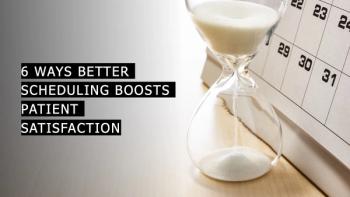
Simple Steps to Boost Positive Patient Visits
When it comes to creating happier patients, skip the perks in the waiting room and instead focus on boosting the morale of your staff. Here’s how.
Want to create more positive patient experiences in your practice? Skip things like installing HD televisions in the waiting room and valet parking and instead, put your energy and your focus on the biggest element in creating happy patients - your staff.
That was the message delivered by consultant Meryl D. Luallin of San Diego-based firm Sullivan Luallin at the MGMA annual conference on Wednesday. A professional "mystery patient" visiting practices nationwide for more than 20 years, Luallin said the key to improving patient satisfaction lies primarily in staff performance.
"Studies have shown that if you work on your 'people scores,' your other areas will improve, including wait times," she said. "The goals are to become known as the organization of choice in the area you serve and beyond, and build a reputation as the employer of choice as well."
Luallin referred to a recent Gallup poll of nearly 9,000 employees that indicated just 29 percent feel "engaged" in their employment - meaning they love their jobs ¬- while 56 percent remain neutral, essentially coming in, doing their work, and going home. That leaves 19 percent as "disengaged." Those are the employees Luallin recommends you shed immediately.
"It would be great if the disengaged would quit and leave, but they don't," she said. "Instead, they quit [emotionally], but stay around."
A good leader at a practice of any size instills passion and pride in her employees. Luallin said it is important for administrators to ask themselves and their staff why their office is a great place to work and why they feel it is special and unique.
"If [administrators] don't know why this is a great place, how can staff members know? If they can't tell you what sets your practice apart, how do you have anything that separates you from other offices?" she asked.
Building pride can be as simple as hearing from the people you serve - your patients.
This can include verbal surveys of patients including post-visit phone calls and patient interviews, and even a simple questionnaire in the exam room about how the visit is progressing and what those visiting hope to expect during their time at your office.
Luallin also advocates that new physicians at your office - handling a low, but expanding patient base- follow-up with patients over the phone about their visit and next steps.
"This is the most effective and cheapest way to build that base," she said. "Have the physician call the patient the next day … and use the time they have to help build the practice. That builds word-of-mouth to other patients and the friends and relatives of the patient being called."
Building passion is just as easy, Luallin said.
There are various ways to do this, but one of the most powerful is to have a former patient, who had a positive experience, come back to share that with the entire staff at a meeting.
"This is your biggest bang for the buck," she said. "If that person had a positive outcome, bring them back to tell their story. I can't tell you how powerful that is … you will have people so passionate and want to duplicate that experience."
Maintaining pride and passion involves an active practice administrator, Luallin said, and also requires some protocols in place, including pre- and post-visit questions and greetings. She used the example of the standard greeting at the Mayo Clinic: "Good morning. We've been expecting you."
"That suddenly makes me feel terrific,” she said. "Does that take more time? No. Staff may feel it will, but it takes no time at all."
Another crucial element to positive patient experiences is knowing the patient's expectations the moment he walks in the door. This can be done simply through a verbal or written questionnaire asking his goals for the visit and, noted Luallin, additional questions the patient might have if time permits - an expectation that needs to be set early on the part of the practice.
"Even when you are scheduling, you need to know upfront what the [patient] expectations are and know exactly what they are being seen for at that visit," she said. "This is a big way to help the doctors stay on time."
But remember, once you've built momentum, you have to sustain it. Luallin emphasizes keeping staff happy through little efforts such as thank-you notes or other tokens of appreciation as well as publishing goals, measurement criteria, and progress reports regularly so everyone knows how close they are to achieving peak patient satisfaction.
Keith L. Martinis associate editor at Physicians Practice. He can be reached at
Newsletter
Optimize your practice with the Physicians Practice newsletter, offering management pearls, leadership tips, and business strategies tailored for practice administrators and physicians of any specialty.














